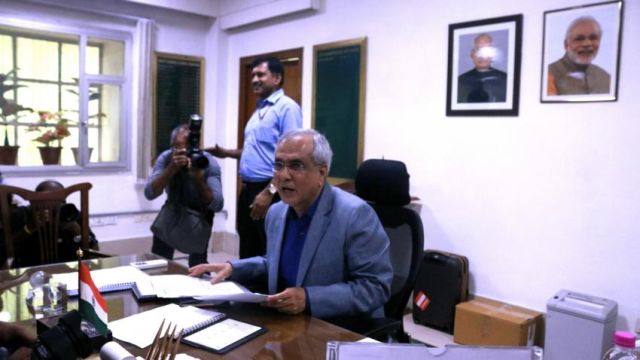
by admin | May 25, 2021 | Economy, News, Politics

Rajiv Kumar
New Delhi : Unfazed by the official data on Friday showing that the Indian economy will grow at a slower pace compared to the last fiscal, NITI Aayog Vice Chairman Rajiv Kumar has said the GDP growth will become more robust in 2018-19.
Kumar’s remarks came after Chief Statistician T.C.A. Anant announced that Indian economy was expected to grow at a slower 6.5 per cent in 2017-18 compared to the 7.1 per cent in 2016-17.
Reacting on the growth estimates, Kumar said the GDP growth in the second half of 2017-18 had risen to seven per cent bringing the annual growth rate to 6.5 per cent.
According to a statement issued by the NITI Aayog, Kumar pointed out that economic activity had been picking up over the last three quarters and can be expected to strengthen in the coming period “with the manufacturing Purchasing Managers’ Index (PMI) now reading at a five-year high of 54 per cent, and FMCG demand picking up briskly”.
“Hence the GDP growth will become more robust in 2018-19.”
He added that the estimates assume significance in the wake of the fact that the higher second half growth had come despite a weaning of public sector expenditures which had peaked in 2016-17 on account of the implementation of the Seventh Pay Commission recommendations.
—IANS
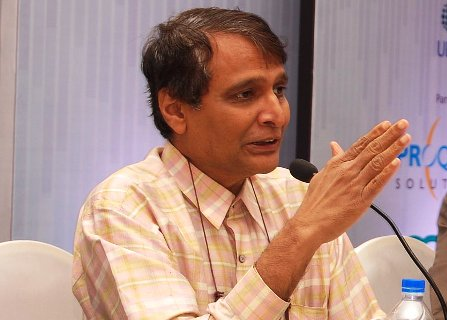
by admin | May 25, 2021 | Economy, Investing, Markets, News, Politics

Suresh Prabhu
New Delhi : India needs massive investments to boost GDP growth that is hovering around 6 per cent in recent quarters, Commerce Minister Suresh Prabhu said on Thursday.
His comments come at a time when domestic private investments in the country have fallen to record lows.
Addressing the 50th edition of the Skoch Summit here, the Minister said that private enterprises must be encouraged to ensure efficient investments in areas critical for the country’s development.
“India needs investments on a massive scale, because more the investments, more the growth,” Prabhu said.
He said that investments must be efficient, as poorly conceived and inefficient investments would not yield the desired results.
“We must use capital in the most efficient manner so that capital-output ratio is good. We need entrepreneurs who use capital in an efficient manner and thus boost growth,” the Minister added.
Reversing five successive quarters of decline, India’s Gross Domestic Product in the second (July-September) quarter of the current fiscal grew at 6.3 per cent, which was higher than the 5.7 per cent growth registered in the previous quarter.
According to experts, the fundamental factor responsible for this situation is the decline in private investments in recent years, both corporate and households, accompanied by the burgeoning non-performing assets, or bad loans, of Indian government banks.
There has been a sharp fall in investment with the gross fixed capital formation rate falling steadily to touch 29.3 per cent in 2015-16 and 27.1 per cent in 2016-17.
Investments by the private sector during 2016-17 grew at 5.8 per cent, recording the slowest growth rate since 1992. The gross domestic savings rate fell from 34.6 per cent of the GDP in 2011-12 to 32.2 per cent in 2015-16.
The top 1,000 non-financial companies made fresh investments of Rs 2.07 lakh crore in 2016-17, which is lower than the Rs 2.9 lakh crore in 2016-17, and all-time high of Rs 5.7 lakh crore in 2013-14.
—IANS
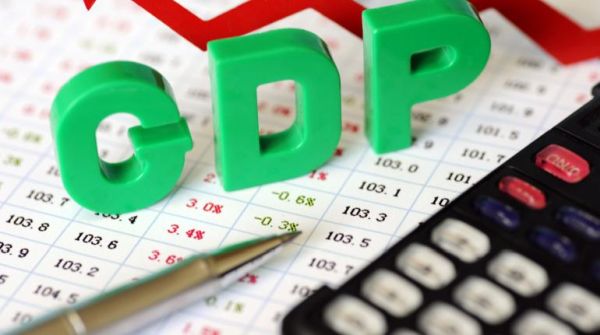
by admin | May 25, 2021 | Opinions
 By Amit Kapoor,
By Amit Kapoor,
The Indian telecom industry is passing through complex times. It has been almost two decades since the Atal Bihari Vajpayee government heralded the telecom revolution with the formulation of the National Telecom Policy (NTP) in 1999. When the policy was enforced, India merely had a million subscribers. Since then, the industry has grown on to become the second-largest telecommunications market in the world that is now well past the billion-mark in terms of subscribers.
Over the years, the sector has become a significant contributor of the country’s GDP and job growth. According to one estimate, it contributed 6.5 per cent of India’s GDP while providing direct and indirect employment to four million people in 2015. The industry has also been one of the fastest-growing sectors in the country with a compound annual growth rate (CAGR) of 7.3 percent over the last decade. This is the result of the dynamic and hyper-competitive nature of the Indian telecom market. Competition among telecom companies has risen to the extent that tariffs are one of the lowest in the world.
However, the pace of transformation of the industry over the course of last year has been astonishing, even by its own standards. It all began in September 2016 with the entry of Reliance Jio into the telecom fray that was already saturated with giants such as Bharti Airtel, Vodafone India, Idea Cellular and BSNL, along with other smaller players. Until then, the industry had derived 75 percent of its revenue from voice and as each operator tried to gain a market share by offering competitive prices, it seemed to have bottomed out reaching as low as $0.01 per minute.
Jio’s entry last year changed the market in more than one way. First, the battle shifted from voice to the data front. Reliance had spent the last few years building the largest LTE (long term evolution) network in the country that allowed it to provide Voice over LTE services at virtually no extra cost — enabling it to offer free calling and only charge for data.
The second significant impact of Jio’s entry has been a consolidation wave that has swept the industry due to escalated levels of competition. This has been so intense that scale has become a necessary prerequisite. In fact, to quantify the increase in market concentration, we calculated the Herfindahl-Hirschman Index (HHI) for the telecom market before and after the entry of Jio using TRAI data.
In a scale of 0 to 10,000 with a higher score implying higher concentration, we found that HHI increased by almost 1,000 points from 1,543 to 2,490 between June 2016 and June 2017. To put matters in perspective, the US Department of Justice considers a market with a HHI of less than 1,500 to be competitive, one between 1,500 and 2,500 to be moderately concentrated and one beyond 2,500 to be highly concentrated.
This rise in HHI has been a result of a spate of mergers that have taken place since Jio’s entry. Bharti Airtel has acquired the telecommunication services of Tata, Telenor and Videocon, while Vodafone is in its final stages of merger talks with Idea. After the merger, Airtel will lose its two-decade-long held position as the industry leader since the Vodafone-Idea combine will command a subscriber base of 400 million as compared to Airtel’s 320 million. At last count, Jio’s subscriber base stood at 138.6 million in September 2017. Considering that it had started from scratch a year ago, the figure is simply gargantuan and presents the incumbents with effective competition and takes the industry towards maturity.
The final impact of Jio’s entry, which is often less talked about, is in its effect on increasing mobile and data accessibility. The Indian telecom industry was adding an average of 54 million wireless and 50 million Internet subscribers each year until mid-2016, as per TRAI (April-June) reports. In contrast, over the course of the last year (June 2016-June 2017), the industry added over 150 million wireless and 80 million Internet subscribers. Jio’s entry in September 2016 has had a clear effect on the acceleration in adoption of mobile technology and, especially, Internet.
An ICRIER study recently pointed out that a 10 percent increase in the rate of growth of Internet subscribers will result in a 2.4 percent increase in the GDP rate. Therefore, there will be clear economic gains from the industry developments that have recently taken place.
India’s telecom revolution has been the driving force of the economy since the turn of the century and it has done well to evolve with the times and climb the data bandwagon. It has largely gone unnoticed, but this year India has also become the highest mobile data user in the world with monthly usage exceeding a billion GB. As data accessibility of Indian consumers increases, it creates a multitude of opportunities for the government to reach out and enable social progress by providing services that were previously not feasible. Tapping into these opportunities can unlock the next phase of growth for the Indian economy.
(Dr. Amit Kapoor is chair, Institute for Competitiveness. The views expressed are personal. He can be contacted at amit.kapoor@competitiveness.in and tweets @kautiliya. Chirag Yadav, senior researcher, Institute for Competitiveness, has contributed to the article)
—IANS
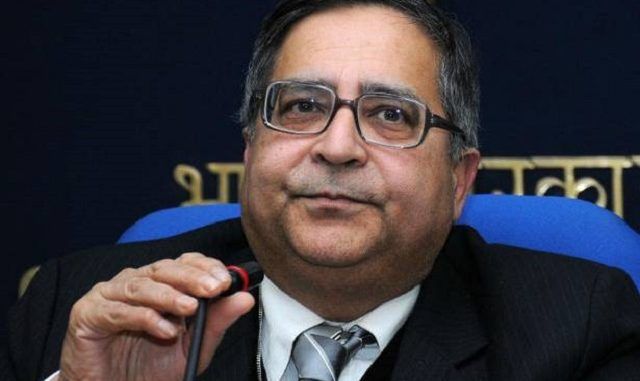
by admin | May 25, 2021 | Corporate, Corporate Governance, Interviews

Government’s Chief Statistician T.C.A. Anant
By Vishav,
New Delhi : Government’s Chief Statistician T.C.A. Anant has no worries that the government may breach the fiscal deficit target of 3.2 per cent of the GDP for the current fiscal. In fact, he feels revenue would be buoyant by year-end and that the targeted deficit would be bridged.
“It’s bad accounting to compare the fiscal deficit reaching 96 per cent of the target in October (compared to 79 per cent last year). They are not taking into account a significant policy initiative that the government has taken this year — the preponement of the Budget,” Chief Statistician T.C.A. Anant told IANS in an interview.
He said it was a conscious policy reform and the surprise about its impact on fiscal deficit was “befuddling” because the move had led to expenditure profile shifting towards the beginning of the year with revenue profile remaining the same.
“This is something anyone could have predicted when we decided to prepone the budget. That, come October, we are going to get a higher fiscal deficit picture,” Anant said.
India’s budgetary fiscal deficit for the first seven months of 2017-18 stood at 96.1 per cent — Rs 5.25 lakh crore — of the full year’s target of Rs 5.46 lakh crore, as per the data furnished by the Comptroller General of Accounts (CGA).
“The Budget preponement was done largely with a view to permit government expenditure to start from April 1… The purpose was to shift the time-profile of the government expenditure to increase the expenditure in the earlier quarters — front-loading.”
“To a certain extent, that has succeeded. Because if you look at the share of government expenditure as a percentage of budget expenditure which was done in the first six months — it is higher this time than the share of expenditure to budget expenditure of last time,” the Chief Statistician said.
However, the revenue profile has remained pretty much the same, he added.
“Just these two phenomena would lead you to get what you should get: A higher deficit this time than you got last year. Remember, the revenue profile also has the bulk of the revenue coming in the last quarter.
“So if the budgetary estimates remain on line, then there is nothing to worry about. Since revenues come in during the last quarter, what you really need to look at is how does it work out in the full year,” he pointed out.
Anant added the reason for the conscious decision to advance the Budget this year dates back to almost a decade when there were a series of reports on expenditure management recommending the same.
These expenditure management commissions had said there was a tendency to bunch government expenditure in the last quarter, which was criticised for a variety of reasons.
“The argument was the quality of expenditure is inferior when you bunch it in the last quarter. Largely what happens is that you are into exhausting the budget, so you spend it on whatever you can spend it on, rather than what you should be spending it on,” Anant said.
“Also, from the viewpoint of capital formation and investment-related things, when you begin expenditure on a project late, the risk of the project getting held up is higher because the budgetary approval will lapse… So the whole work will be held up until the amount gets reauthorised,” he said.
Anant added that the budget schedule was a detriment to front-loading because the formal authorisation was often not made available till some time in June, which used to create a handicap because, by that time, the monsoons used to set in and some activities could not be initiated.
“So all of this was a conscious choice as to why you would wanted to bring the budget date a little ahead so you could begin the expenditure on April 1,” he said.
(Vishav can be contacted at vishav@ians.in)
—IANS
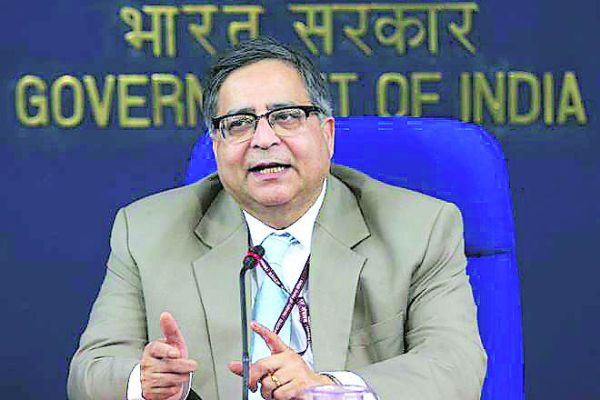
by admin | May 25, 2021 | Interviews

Chief Statistician T.C.A. Anant
By Vishav & Biswajit Choudhary,
New Delhi : The factors responsible for a five-quarter slump in the growth rate, including the adverse effects of demonetisation and GST implementation, have played out and the Indian economy is now poised to take an upward trajectory in the coming quarters, says the government’s Chief Statistician.
He also feels that concerns over slow agricultural growth and inflation were “over-blown” and that the current fiscal would “certainly end with inflation below four per cent”.
Although refusing to forecast the GDP growth rate for the complete fiscal, Chief Statistician T.C.A. Anant says the likely direction was going to be upward.
“If one considers the factors which led to a decline in GDP till the fourth quarter of the last fiscal and the first quarter this fiscal, it would be possible to argue that those factors have worked their way out and we should, therefore, see an improvement in growth,” Anant told IANS in an interview.
The first factor, Anant said, had to do with global commodity prices. These had crashed in 2014-15, resulting in lower input costs that boosted growth rates in 2014-15 and 2015-16. But once the commodity prices recovered they pulled down growth rates, as reflected in the slowdown in the last five quarters.
“Now, the general reading of market experts is that they are likely to stay at this level. If that expectation is maintained, then on this ground, I don’t expect to see any further changes or influence (on GDP calculation) from this source,” he said.
Last week, the CSO released the nation’s GDP for the quarter ending September, which showed a break in the slump of the five quarters, a rise in the manufacturing sector’s output and the economy poised to take an upward path in the coming quarters.
Anant added that there were also several domestic factors at play, including the crisis in the real-estate sector which saw very rapid growth in the high-growth period, and somewhat linked to it, the non-performing assets (NPA) situation.
“The government sought to address this problem through creating a new governance regime for the real estate sector. This regime is now in place and its adoption is under process. In so far as the real estate sector is concerned, the expectation is that as and when the adoption process becomes more complete, we will expect to see a revival in the sector,” he explained.
Regarding the NPA crisis, “which is causing a certain degree of drag in so far as private investment is concerned”, Anant said the process of creation of NPAs, or assets which turned bad, was now over to a certain extent and the economy was in the phase of trying to resolve the issue.
“In addition, during 2016-17, there were short-run effects caused by currency replacement where old notes were de-notified and a replacement process was put in place which led to a temporary shortage of cash. That cash replacement was pretty much complete before the end of the fourth quarter of last year.”
“The fourth major structural change which influenced the decline in growth rate up to the first quarter was the fact that the government decided to introduce the GST. This also created a natural disruption, particularly in manufacturing companies which were faced with the difficulty of the treatment of goods produced prior to GST and were, in their judgment, supposed to be sold after GST came in,” Anant elaborated.
He said this uncertainty led manufacturing companies to first pull down production and then get rid of inventories, all of which came to an end on July 1.
“If you look at all of these events as causation to the declining story which we see in place from the last five quarters, given the sort of responses which have been put in place to them, the belief is that you should now see an upward trajectory.”
“All of these have, so to speak, played out. Or at least the negative elements of these have played out. Their positive elements are still being played out. So if you put all of that together, the likely direction is going to be upward… The growth should improve. But how much is very hard to quantify,” Anant said.
Though the Reserve Bank of India (RBI) adopted a neutral stance on the policy rates earlier this week citing pressure on prices as one of the main reasons, Anant dismissed the concern over inflation.
“We are at a much lower level of inflation than we have ever been any time in the past… In fact, my judgment personally would be that we are going to end the financial year certainly below four per cent.
“The reason why I expect inflation to fall is because one of the factors which has led to prices rising in the last couple of months is food and we are now in the seasonal part where food prices tend to traditionally soften. So chances are that you would probably see the overall effect, even if it rises a bit, would not exceed four per cent. That’s my judgment,” Anant said.
On the slowdown in agricultural growth, the Chief Statistician said while there was a concern, it was over-blown. While there still is considerable dependence on the monsoon, agriculture had become a lot more robust, he said.
“In fact, if you look at our data, our output figures show much less volatility than moisture data, or monsoon data.
“This year’s production relative to last year is slightly lower. But if you look at it in a long-term perspective, this year’s production is substantially better than not just the previous two years — which you can say were drought years — but (also in terms of a) long time series, it is better than the best which was achieved any time in the past, even four or five years ago, when you had very good monsoon,” Anant said.
(Vishav can be contacted at vishav@ians.in and Biswajit Choudhury at biswajit.c@ians.in )
—IANS





